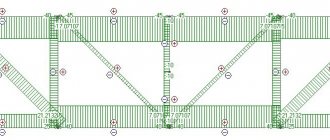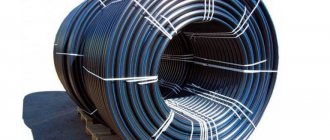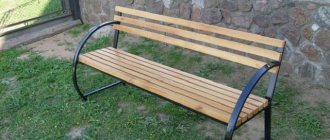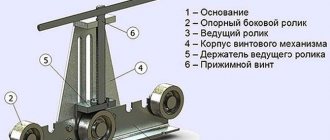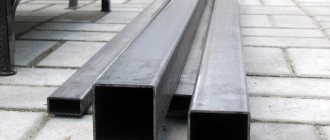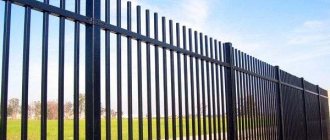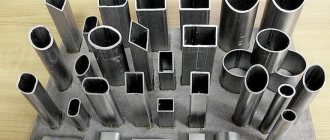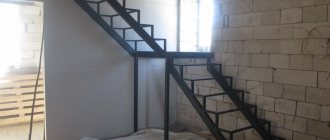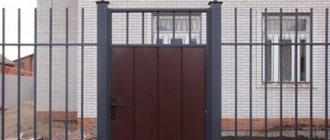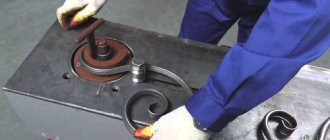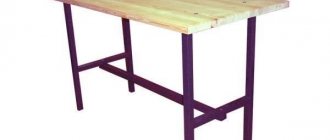Cutting Rules metal grinder
Metal is the material for which an angle grinder (angle grinder) was originally intended to work. Now it is used to cut reinforcing bars, various metal sheets, pipes of various diameters, brick, concrete, stone, tiles and other building materials. How to cut a pipe smoothly under different conditions to cut a cast iron pipe
Bulgarian Thanks to the presence of a variety of attachments, the grinder also allows you to polish without grinding the surfaces of products. Cutting metal with a grinder is one of the main, most common jobs. To reduce the likelihood of injury, oil handling must be performed correctly, in compliance with general non-personal safety requirements.
Preparing to use a grinder for metal
The grinder belongs to the category of relatively dangerous power tools. There is an option to get injured from a flying disc or a tool falling out of your hands. In any case, the danger is associated with the high rotation speed of the device’s electric motor.
To increase the efficiency of the grinder and expand its functionality, the following additional devices are actually used:
Their use makes it possible to improve the quality of sawing metal workpieces and increase the accuracy of the process. Working conditions also improve in terms of safety, and productivity increases.
The use of additional accessories allows you to use the tool as a machine designed to perform different types of work.
To make the cutting process as safe as possible, working on metal with an angle grinder should follow a number of rules. They are conventionally divided into preparatory and not main (working) activities.
Before cutting begins, a number of manipulations must be carried out.
- Wear special work clothes, not shoes (with anti-slip soles), gloves made of thick fabric or leather.
- Prepare a suitable disk, based on the characteristics of the type of metal being cut, and finally install it with the markings facing up, holding it with a nut.
- Check the working attachments used for the presence of various defects that impair their integrity: potholes, cracks and other deformations.
- Use personal protective equipment: goggles, a respirator or mask (shield), and sometimes also not headphones.
- Check the functionality of the tool, the reliability of its casing (working without it is strictly prohibited), and the condition of the power cord and plug.
- Prepare the work site: remove flammable materials (lubricant, fuel, paper, rags) and all obstructive things. Cover differently and move to a safe distance objects that can be damaged by hot metal particles.
If possible, the material to be sawn should first be securely fixed, for example, in a vice, in order to eliminate possible accidental movements. It is prohibited to hold the workpieces in the palm of your hand or between your knees.
Correct use of the tool
When you start sawing any part using an angle grinder, you should adhere to these rules.
- When cutting metal, you need to hold the grinder firmly, with both hands.
- The wheels can be changed only after their rotation has completely stopped and has not cooled down to an acceptable temperature, having disconnected the power tool from the power supply.
- Do not place the working tool on the ground, or in other words, the table (do not let it out of your hands).
- It is required to periodically stop for about five minutes to rest so that the disk does not cool down.
- It is necessary to constantly take care of the condition of the cutting wheel, preventing it from being pinched by the edges of the workpiece being cut.
- Do not leave the tool plugged in unattended.
- Use only discs of the correct size as specified in the operating instructions for the device you are using.
- It is better to do the work on a flat surface so that the body position is stable.
- Make sure that the power cord is kept away from the rotating circle, sharp edges, and objects heated above one hundred degrees.
- Movements not directly related to cutting must be performed only with the power tool turned off.
- You need to be positioned on the side, that is, behind the tool, doing the work yourself so that parts of the body are not in the cutting plane.
When cutting metal with a grinder is finished, you should wait for the disk to stop working and disconnect the power cord of the tool from the mains. Afterwards it is recommended to make sure there are no signs of fire. When cutting materials, a right-handed person should correctly hold the handle of the device in the area of the on/off button with his right hand. In this case, the left hand is located on the handle screwed into the body of the power tool from above.
It is unacceptable to perform work using an angle grinder in a very tired state, or under the influence of alcohol, psychotropic or narcotic drugs.
As for the question of which direction—toward or away from you—the disk of a switched-on angle grinder should rotate, there is no definite answer. The operating instructions indicate that the first option is correct. This is due to the fact that the resulting sparks fly away in the direction opposite to the operator, without causing harm. Also in this direction, fragments of the circle will fly if it breaks into pieces.
However, if the passage occurs, when the rotating disk jams towards itself, the tool will fly off towards the worker. Therefore, some experts prefer to cut metal so that the circle rotates “from itself”. A power tool torn out of your hands will fly in the opposite direction. This reduces the likelihood of injury, and men’s clothing, shoes, and gloves will protect the user from flying sparks.
We measure
The first method is not entirely convenient, but quite accurate. Suitable if you are “in the tundra” and have nothing at hand except a pencil and tape measure. I had to use it a couple of times. The diameter of the pipes does not matter.
An important condition is the presence of a flat plane near the cut. This could be the edge of a pipe, a socket, a put-on or welded-on coupling, a seam, or any other concentric circle.
We mark the place of the cut with a risk. We measure the distance from the mark to a flat plane. We rearrange the tape measure along it and make risks in a circle, using the given size. We get a circle from the marks.
Cutting sheet metal with a grinder
To cut metal of different types and thicknesses, use appropriate cutting wheels of different thicknesses and diameters. The algorithm for sawing sheets is as follows.
- To cut using a grinder, sheet metal is first laid on a flat surface.
- Mark with chalk (marker) the exact dimensions of the cut out fragments along the sheet.
- Sawing is carried out along the marked lines, without simultaneously changing the angle of the initial inclination of the disk to the working surface, so that it does not jam or break the power tool.
If you don’t have the skills to saw sheet metal with a grinder, it is recommended to first practice on soft material - this will allow you to get a feel for how the tool works.
You need to think about whether the lower near segment of the disc cuts metal more effectively.
When cutting a sheet of metal, the following recommendations should be taken into account to obtain a high-quality result.
- To improve cooling, it is necessary to water the sawing area with water, which will also increase the life of the wheel.
- You should start cutting metal only when the disk is rotating: you cannot turn on the tool if the stationary circle is in contact with the surface of the workpiece.
- To saw tin (thin sheet metal) and cut out different geometric shapes in a different way, it is more convenient to use small, worked out circles (“stubs”).
- Pressing the angle grinder with significant force is harmful: cutting should take place almost exclusively under the angle grinder’s own weight.
- If the cutting wheel stops in the slot (when you turn off the power tool), then of course you can resume work only after removing it.
Cutting upon purchase
If you buy reinforcement in a store or warehouse in small quantities, ask workers to cut it into pieces of the length you need right there. Typically, many sellers provide this service (for a fee or free of charge), trying to attract as many buyers as possible, since cutting reinforcement in this “method” is much more profitable:
- you don’t have to look for a car and transport long reinforcement bars;
- the reinforcement will arrive at your construction site already cut into pieces of the required length, and you can immediately start working with it;
- you do not need to cut the reinforcement yourself and look for the necessary tools for this.
Just remember to calculate in advance the number and length of reinforcing bars you need.
Cutting a round hole in metal using an angle grinder
In reality, it is often necessary to cut a circle in metal, and the only tool available is a machine. How to cut slate has been produced with a wave and grinder since the times of the USSR. Alas, it is quite enough for this. The algorithm of actions is simultaneously as follows.
- Draw a circle with a compass on metal or on a pre-made paper (cardboard) template with chalk, also called a marker.
- Holding the grinder at an angle to the surface of the sheet, make a preliminary marking cut of the metal along the marked contour, making short movements with the disk (sawing in small sections).
- Then, moving the nozzle in the same way, deepen the slot until it is completely cut out.
You need to cut along the outer contour of the circle so as not to reduce the size of the circle. If its diameter is small, then they cut by touching the metal with a disk point by point (without longitudinal movement of the nozzle). The round hole will have an oblique cut, additionally with some minor flaws (they depend on the skill of the worker). Afterwards, it is processed, if desired.
The process of cutting a round hole in sheet metal using a special device is shown in the video:
Features of working with thick metal, copper, cast iron, aluminum
When it is necessary to cut thick metal into separate fragments, it is recommended to additionally perform the following steps:
- produce what remains to be done for our client, cuts only in a straight line;
- different curved contours should be cut out in separate straight sections of short length, while removing unnecessary parts;
- It is necessary to completely saw the workpiece over several approaches, with each subsequent step deepening the slot;
- if you need to cut corners, I-beams, channels, rails, then each of their structural parts is sawed separately.
Cutting cast iron, stainless steel, in addition non-ferrous metals, nettle, aluminum and copper, is carried out using special wheels designed for working with these materials. All necessary information about the discs is contained in the markings of these products, printed on their sides. At the same time, the circles differ in the composition of the fillers:
- in some, the additive is a super-strong material that can cut alloy steel;
- others use mild binders.
Cutting stainless steel with conventional metal cutting discs is prohibited, because they contain substances that lead to accelerated corrosion of the cut site . Aluminum and copper are very viscous non-ferrous metals. They are sawed using a grinder, pouring kerosene over the slot formed by the disc. In this case, it is necessary to comply with fire safety rules.
Recommendations for cutting metal pipes
Cutting pipes from different metals is a popular operation when carrying out repair and construction work. How to cut correctly with a grinder, rules for using the tool. In order to cut copper pipe or steel sheet, it is better to use a metal circular saw, however, keep it. Products have to be cut off when installing sewer and heating systems and water lines. In this regard, the grinder copes well with various tasks. Discs for work are selected according to the material from which the pipe is made.
The use of a corner makes it possible to:
- sawing pipes at different angles, for example forty-five and ninety degrees;
- cut products;
- cut profile (rectangular or square) pipes smoothly;
- perform longitudinal cutting of tubular blanks;
- sawing cast iron pipes;
- cut thin-walled tubes.
If you need to cut a large diameter pipe, then using a grinder allows you to complete this work without significant financial costs. But at the same time, labor productivity is low, and the risks are considerable. When long pipes lie on supports, only the hanging parts are sawed off. If you cut in the center, the cutting edges will jam the cutting wheel, which will lead to jamming of the tool and possible injury.
Specialists not only cut pipes from different materials at the required angles, but also cut holes of the required shapes in them. Work with profile and round workpieces is carried out in a similar way, with mandatory observance of safety regulations.
Precision cutting devices
Band saws are characterized by high stability of the plane of movement of the blade and cutting accuracy. They are also widely used in procurement areas of small-scale and medium-scale production. They are characterized by versatility, reliability and high performance.
For private use, the MASS company from Italy offers a compact band sawing unit. It is equipped with a manual clamping device and can smoothly cut pipes with a diameter of up to 65 mm, as well as rolled sections of any profile of the same thickness.
The rotary device allows you to set an arbitrary cutting direction from 0 to 45°. The frequency of movement of the cutting blade is up to 45 strokes per minute. An economical 370 Watt motor allows you to use a regular home single-phase power supply with a voltage of 220 V.
Sawing pipes at different angles
It is necessary to cut round and profile pipes at an angle of forty-five and ninety degrees when laying various communications. In any case, it is necessary to saw off the pipe evenly so that the elements that need to be connected are connected to each other as tightly as possible.
A cut at an angle of forty-five degrees for cylindrical pipes is carried out as follows:
- take an ordinary square sheet of paper;
- fold it exactly diagonally;
- This template is used to wrap the pipe;
- use chalk or other marking device to mark the future cutting line;
- remove the template;
- clamp the workpiece in a vice;
- cut off the marked piece of pipe.
When applying the template, either of the two short sides of this triangle should be parallel to the central axis of the pipe.
When it is necessary to cut at an angle of ninety degrees, the pipes are simply wrapped in a circle (cylindrical) or around the perimeter (profile) with a sheet of paper. After this, mark the cutting line. You can also mark a profile pipe very simply using a regular square.
If it is necessary to cut a significant number of profile pipes at an angle of forty-five and ninety degrees, appropriate templates are made from this material, only with a larger cross-section. This allows you to perform the required measurements only once. In this case, a construction square or a protractor is used for initial marking. When the template is made, the cut pieces are inserted inside it, marking the cut lines. Then sawing is done.
Templates are also made for other angle values. How to cut slate, how to cut slate with a classic grinder. This method increases labor efficiency.
How to cut a profile pipe evenly
You can cut a profile pipe in much the same way, but here it will be easier to use a square.
The device is applied to each side in turn, for which the element to be cut will need to be rotated, and markings are applied. Next, the pipe must be secured firmly and work can begin. Any suitable tool can be used for sawing. If you have to cut a lot of pipes, then it is advisable to make full-fledged templates from scraps. In this case, measuring and marking work will have to be done only once.
Features of cutting cast iron and thin-walled pipes
Cast iron is a brittle material. To cut a cast iron pipe with a grinder, proceed in the following sequence:
- mark the cutting line;
- placed under the pipe, which will serve as a support for it;
- make a cut along the contour several millimeters deep;
- insert a chisel into the recess made;
- the instruction is hit hard and sharply with a hammer.
After the impact, the pipe will split along the cut line. Its edges will be quite smooth. If necessary, they are further processed.
To perform longitudinal sawing of a pipe, accurate marking is also important. To apply it, various devices are used, for example, construction thread (“beat”). The entire sawing process should be carried out carefully, slowly, so as not to stray from the marked line.
Thin-walled pipes are one of the varieties of this type of product. They are often made of non-ferrous metals: copper or aluminum. Cutting them is a difficult task. In this case, you should use grinder wheels that match the material of the workpiece.
Sawing thin-walled tubes must be done very carefully, because they can easily become deformed even when a slight load is applied.
To reduce the likelihood of bending of the cut part, various bulk fillers are poured inside it, for example, ordinary purified sand.
How to cut lengthwise
Another frequently asked question is how to evenly cut a pipe lengthwise with a grinder. Here the algorithm of actions will be approximately the same as for transverse cutting. It is important to pay attention to marking.
You can, for example, use painting thread, which is usually used when marking walls. In this case, it is necessary to firmly fix the pipe. The sawing process itself must be done carefully and slowly, since when sawing long elements there is a high probability of the cutting disc slipping from the marking line.
Cutting corrugated sheets and metal tiles
in practice, you have to face the need to cut a profile sheet or metal tile. These materials are made of steel, which is coated with zinc and polymer protective layers and painted.
There are different opinions regarding the possibility of using a grinder for cutting them. The installation instructions say that the corrugated sheet cannot be sawed using an angle grinder. To do this you need to use other tools. But they need to be purchased, which is not always justified by the volume of work to be done, and also requires additional financial investments. When there is no tool other than an angle grinder, before sawing with a grinder, you should know the possible negative consequences.
- If you cut metal tiles or corrugated sheets an angle grinder
, the protective coating in the cut area and a little near it will be destroyed, and the cut edge will begin to rust. - The material is removed from warranty.
- Flying sparks can not only ruin the appearance of the rest of the sheet (sear the paint), but also damage the polymer coating.
- The edge of the cut may turn out torn.
All considered negative consequences can be minimized if you cut corrugated sheets or metal tiles with a grinder, following the following recommendations:
- carry out all work immediately before installation;
- treat cuts with anti-corrosion compounds;
- cover the cut edges with a primer and paint;
- use metal discs of minimal thickness (up to one mm);
- To keep the edges neat, you need to cut quite quickly;
- Carefully sand the torn edges.
Before sawing, as usual, the sheets are marked.
If you need to cut a square, do this:
- draw it on the surface of the sheet;
- cut through the material along the marked contour with a grinder;
- At the end, carefully cut out each corner.
Circles or other shapes are cut out using the same pattern.
Using a grinder for cutting metal tiles and corrugated sheets makes the job easier. It becomes more convenient to perform it, because you can adjust the sheets to size directly on the roof.
In order for metal tiles or corrugated sheets to remain under warranty, you should measure the object and order factory cutting of the sheets. You can also try to choose a material with dimensions such that trimming is not required.
Cutting metal with a grinder is a cheap, practically accessible and quite effective way of sawing it. In this case, appropriate discs without defects should be used for each material. Not only the quality of the result obtained, but also your own health will depend on this. How to cut a pipe evenly so that it can be sawed with a grinder and trimmed. When cutting metal, it is imperative to follow safety rules and use personal protective equipment. You should always remember that when working with an angle grinder, any shortcomings or inattention can result in injury. Therefore, you need to work with concentration and caution.

